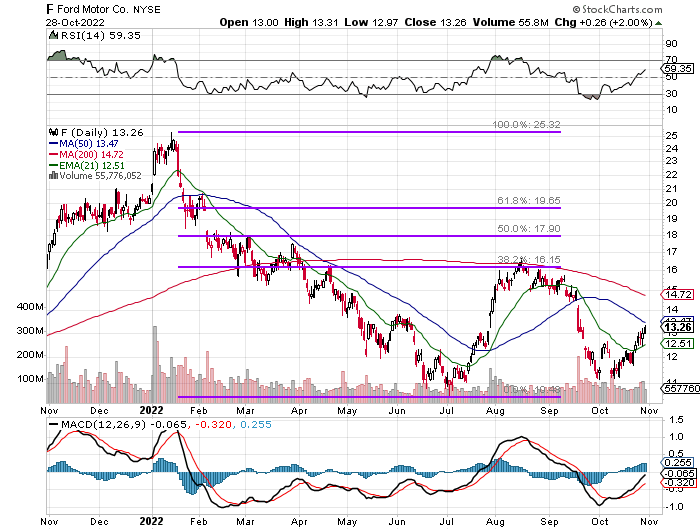On Monday morning the Wall Street Journal reported that the Ford Motor Co (F) would offer severance packages to some white-collar employees who have eight years of service or more and whose performance has been deemed to have been in decline.
This is the start of broader changes being made by the firm in the way it manages US salaried employees. These employees will be offered a choice of opting for severance or enrolling in a performance enhancement course that will take four to six weeks to complete.
The catch there is that those choosing the course who fail to improve upon their performance will relinquish any eligibility for severance. Additionally, managers with underperforming employees with less than eight years with the firm can skip right over the enhancement course and move towards separation with severance.
The Numbers
Last week, Ford Motor posted third quarter adjusted EPS of $0.30 on revenue of $37.2B. The bottom line number was in-line with expectations, while the revenue print was good enough for year over year growth of 12 % and beat Wall Street. That print also showed accelerating sales growth from the second quarter. However, all is not “just peachy” at Ford. On a GAAP basis, Ford put together an EPS print of a loss of $0.21. Year to date, that GAAP EPS is now up to a loss of $0.81. Why is that?
Like many firms, think Meta Platforms (META) for one, Ford is bust spending on where it sees its business going. Unlike META, Ford seems to understand that exorbitant spending at times needs to be curtailed. Ford took a $2.7B non-cash, pre-tax impairment charge on its investment in “Argo AI”, which translated into a loss of $827M for the quarter just reported.
Ford CEO Jim Farley signaled after the release that a pull-back on efforts to develop level four autonomous vehicles was in the offing. Level 4 autonomous vehicles are capable of full autonomy in proper settings with little or no assistance or intervention from a human driver. If the human takes over, the AI disengages. Farley had indicated that investments made in level 2 and level 3 autonomous driving are more likely to have a better result for the firm in the immediate future while also being more economic for the company. Nothing above level 2, such as Tesla’s (TSLA) “Autopilot” is commercially available today.
On The Bright Side
Ford did report operating cash flow of $3.8B, and adjusted free cash flow of $3.6B. As a result, the firm now sees full year adjusted EBIT of roughly $11.5B, which would be up 15% from full year 2021. The firm also guided full year adjusted free cash flow to $9.5B to $10B on strength in its automotive operations, but also due to the firm’s restructuring of its businesses outside of North America.
Balance Sheet
Ford ended the third quarter with a net cash position of $40.173B, and inventories of $15.213B. This cash balance is down 19% over the past nine months, while inventories are down 26.1% over that time. This is with current assets totaling $108.088B, which is essentially flat (down small) from the start of the year. Current liabilities come to $90.167B. This too, is essentially flat from December 31, 2021. This puts the firm’s current ratio at 1.20, which is very solid and flat over nine months.
I do not necessarily love the increase in inventories, but that does not yet present an issue. Recession comes and the cash would be worth more than bloated inventories. The firm’s quick ratio stands at 1.03, which is still above one, which is what we like to see.
Total assets amount to $246.919B. The firm did not pad that number with entries for intangible assets. Total liabilities less equities total $204.83B. This includes $65.206B in long-term debt at Ford Credit and another $19.073B in long-term debt at the rest of the company. Obviously, I do not like to see a firm’s debt-load run at more than twice the cash on hand, but this balance sheet does pass the smell test, especially in the short to medium term.
So, Should We?
It’s been a while – nearly a year – since I have been in Ford. Has the time to re-engage with this firm, whose CEO I do believe to be one of the best? The stock trades at just 6 times forward looking earnings. As we see, there are reasons for that.
General Motors (GM) for that matter trades at just five times. Ford did just announce a $0.15% quarterly dividend payable on December 1st to shareholders of record on November 15th. At Friday’s closing price, that’s a monster yield of 4.52%. This would be the highest yielding stock on my book if I jumped in. Currently The Southern Co (SO) is my yield champion at 4.1%.

Readers will see that Ford was rejected at the 38.2% Fibonacci retracement level of the January through early July selloff. The stock has since sold off hard again and is now trying to rally for a second attempt at that line. Ford will face potential resistance at its 50 day and 200 day SMAs ($13.26 and $14.72, respectively).
That said, relative strength is solid and the daily MACD is rapidly improving despite the fact that the 12 and 26 day EMAs stand in negative territory.
My feeling is that Ford can be purchased slowly with the intent to accumulate a moderately sized (2% to 2.5% allocation?) long position for portfolios in need of increased revenue generation. I would rather act on this intention on weakness. I might initiate at the 21 day EMA (currently $12.51), whenever that contact is made. I would not chase.
(Ford is a holding in the Action Alerts PLUS member club. Want to be alerted before AAP buys or sells F? Learn more now.)
Get an email alert each time I write an article for Real Money. Click the “+Follow” next to my byline to this article.
Source: https://realmoney.thestreet.com/investing/all-is-not-peachy-at-ford-and-there-s-no-reason-for-traders-to-chase-it-16107115?puc=yahoo&cm_ven=YAHOO&yptr=yahoo
